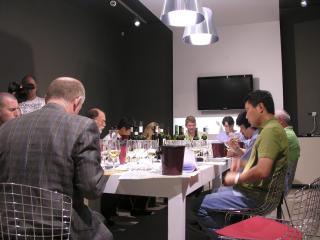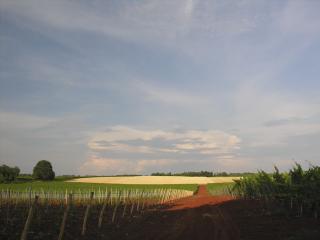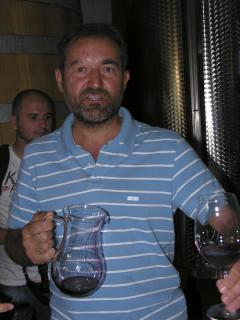Croatia. Part 2: The Istria Connection
POSTED ON 19/07/2009Our tour leaders, Saša Špiranec and Ivona Grgan, promised, in Istria, a wine and food gourmet paradise. Our first stop, dinner at Nenad Kukurin's restaurant Kukuriku on a terrace in the hills overlooking the bay at Opitija (www.kukuriku.hr), lived up to its billing. Istria is the heart-shaped peninsula sitting in the north-western corner of Croatia, and being so close to Italy, it’s not surprising to find a strong Italian influence here. Kukuriku is the epitome of sophistication, its food based on the principles of ‘mar e monte’, i.e. sea and mountain. Without running through every course in detail, suffice it to say that pasta, ricotta, fresh scampi, sea bream, foie gras and lamb featured prominently on the menu. Each dish was washed down with the local sauvignon, malvazija and merlot, each inevitably and enjoyably accompanied by a drizzle of Croatian olive oil here (I couldn’t tell it from Tuscan), a shaving of summer truffles (tuber aesivium) there.
 Tasting malvazija istarka
Tasting malvazija istarka
Roughly 80 kilometres from north to south, Istria is sparsely populated, colourfully green, hilly unspoilt countryside. Away from the popular coastline on the Mediterranean, where houses spill down slopes towards the vast smooth bay that lies between the peninsula and the mainland, stone farmhouses and villages sit in a rural landscape dotted with oak, olive and blue splashes of lavender, with pretty, hilltop towns and houses clustered around the obligatory towering Roman Catholic church spire. Much of it reminds you of central and coastal Italy.
There are 5000 hectares of vineyard land in Istria, on a mixture of red clay (weathered limestone), white (limestone) and grey soils. While it used to be 80% red wine country , the main variety today is the white, malvajija istarka, with 3000 hectares planted, along with pinot blanc, muscat, sauvignon blanc and chardonnay. Red wines are made mainly from teran (related to north-east Italy’s refosco), also merlot, plus cabernet franc and sauvignon, and now some syrah and other new varieties. Malvazija flourishes here as a crisp dry white, a Croatian answer to Spain’s albarino or Austria’s grüner veltliner, not quite like one or the other, but occasionally resembling them, or Loire chenin blanc, especially in their refreshing dry flavours and their affinity with the local seafood and shellfish. It’s a vigorous variety so for the best results come from low-yielding vineyards (for more detail see the tasting of malvazija at the end).
 Moreno Coronica's vineyard
Moreno Coronica's vineyard
It isn’t like any other malvasia I’ve come across before and indeed malvazija istarka does seem to be an indigenous strain with its own character. In its youthful, fresh manifestation, it’s not so much aromatic as richly fruited, concentrated and textured with a refreshing spritz, sometimes a slightly peppery scent, and always with a good firm backbone of fresh to steely acidity bringing a refreshing bone dry and sometimes mineral character. There are 100 or so members of the Istrian wine association, 26 of them qualifying this year (renewable each year for wines that reach the required standard) for the IQ designation of quality. Saša tells us meanwhile that ‘for consumers it’s not so much the classification that counts so much as the brand name’.
 I'll have a jugful, please, Moreno
I'll have a jugful, please, Moreno
We visit the estate of Moreno Coronica, one of Istria’s best producers, whose bright chocolatey red soils look like the terra rossa vineyards of Coonawarra. He makes wine from 30 hectares, including 20 hectares of his own. According to Coronica, the soils are the product of the soil erosion of the Dolomites and composed of 60% clay. Although he doesn’t sport an organic label, he’s effectively organic as he doesn’t used herbicides or insecticides and few sulphur and copper sprays. Coronica started business in 1992 and dates the start of the modern Istrian wine industry from that period because before it wasn’t legal until then for growers to bottle their own wine. According to Saša, growers in recent years have been given subsidies to plant vineyards (although that’s coming to an end in the next couple of years), contributing to the revival of the Istrian vineyard, which was ten times the size before WW2 but systematically abandoned during the communist era.
You can see the sea from Coronica’s meticulously pruned vineyards, looking like rows of neat hedges on an almost edible-looking, chocolate red soil. Teran is a difficult, vigorous red grape variety with big loose bunches. It needs to be low-yielding to be any good. The name he believes comes from the Italian terra but it’s a moot point. His merlot from barrique is delicious, with bright cherry aromas, succulent black cherry fruit, excellent refreshing acidity and smooth textured tannins. The oak (half new, half used) is really well done. His teran straight from the barrel is absolutely stunning, bright, floral, perfumed, almost violety, lovely dark cherry and mulberry fruitiness cut by bitey damsony acidity and layered with a glossy sheen of oak, bringing texture and acting as a suitable counterpoint to the grape’s fresh acidity. ‘Teran expresses the Istrian peasant but mine comes from Oxford’, says Coronica, his self-confidence fully justified.
 gratuitously, Miss Croatia again
gratuitously, Miss Croatia again
Cream of the Crop – A selection of the best Istrian Malvazijas (Malvazija Istarka)
2008 Malvazija Istarka, Terzolo
Grassy, almost sauvignon-like aromatic freshness, crisp with a lemony Graves-like quality, very distinctive and refreshingly, bone dry on the aftertaste. 89+
2008 Malvazija Istarka, Poletti
Fresh and aromatic with notes of elderflower on the nose, lots of juicy stonefruit flavour and lemony acidity; well-crafted, textured, refreshingly juicy and dry with a mineral, dry finish to it. 93
2008 Malvazija Istarka, Festigia
Fresh, lightly spicy aromatic quality, textured stonefruit and citrusy acidity, bone dry with an appetising, almost chablis-like bone dryness and mouthwatering acidity; spritz-fresh and pure. 89+
2008 Malvazija Istarka, Gerzinic
Aromatic, nicely fresh, ripe, textured apple and stonefruit, juicy apple and pear fruitiness on the palate, crisp and bone dry, with an almost austere bone dry appley bite on the finish. 90
2008 Malvazija Istarka, Matosevic Alba
Bright refreshing apple and pear fragrance and fruit aromas, juicily refreshing peachy fruit flavours with a lean streak of mouthwatering acidity making for an appetizing, bone dry seafood-friendly dry white. 90
2008 Malvazija Istarka, Coronica
From one of Istria’s best wine producers (see above), this has a refreshing creamy character on the nose and like its predecessor, its lean streak of acidity and mineral dryness of fruit gives it an elegant fish-friendly feel. 90
2008 Malvazija Istarka, Radovan
This is fresh and aromatic with a lightly peppery overtone on the nose, almost grüner veltliner-like; it’s refreshingly spritzy and distinctive with juicy apple and pear fruit made in a seamless, intensely flavoured and hugely drinkable style. 91
Also good from 2008
Kozlovic
Benvenuti
Arman Franc
Matic
Trapan Ponente
Earlier vintages
2006 Malvazija Istarka, Matosevic Alba
Fermented in oak, this has a baked apple and sourdough nose, the fruit is slightly baked apple and full, like a traditional meursault, a tad on the strong side and with some obvious oaky notes, but distinctive. 89
2007 Malvazija Istarka, Trapan Uroboros
Fermented in acacia wood barriques, the oak is really well-integrated, the texture full-bodied and rich, a sourdough-like character and excellent, full-flavoured stonefruit characters with a mineral intensity (a sort of cross between good anjou and pinot gris). 91
2005 Malvazija Istarka, Matosevic Alba Robina
Another Malvazija fermented in acacia wood barriques, this has baked toffee apple flavours , fine richness of fruit and a kind of evolved smokiness that makes it intriguing and intense; almost chenin-like in character thanks to very good acidity. 92
2006 Malvazija Istarka, Kozlovic Santa Lucia
Big, rich, powerful appley fruit flavours, lots of concentration and richness with a honeyed quality; very complex, intensely flavoured and remarkably fresh. 93
2007 Malvazija Istarka Clai Svetti Jakov
This is what you might call ‘out there’; evolved ginger spice and rose petal aromas richly concentrated fruit with undertones of ginger , herb, honey and cumin, with cider apple fruit and notes of Turkish Delight; a sort of wild and wacky Istrian vouvray. 92
Also good:
2006 Malvazija Istarka, Roxana Antica
Coming soon: Croatia part 3

